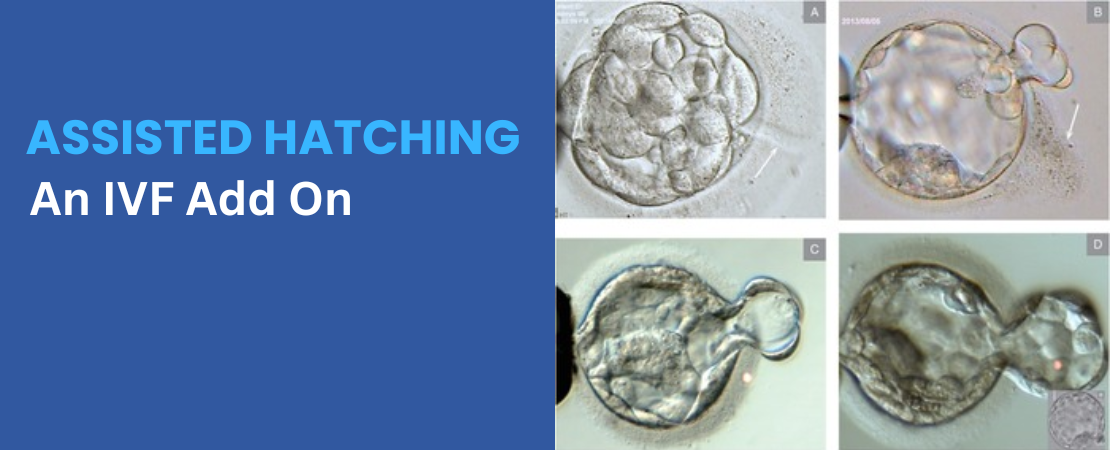
How effective is Assisted Hatching in IVF?
Assisted Hatching is an Add-on in IVF aimed at enhancing embryo implantation by facilitating the embryo’s escape from its protective outer shell, the zona pellucida. This process is critical, as successful implantation into the uterine lining is a prerequisite for pregnancy. Assisted Hatching in IVF involves creating a small opening in the zona pellucida through mechanical, chemical, or laser methods, thereby potentially increasing the likelihood of implantation. The zona pellucida serves multiple functions, including safeguarding the developing embryo and mediating sperm binding during fertilization.
Mechanisms of Assisted Hatching
The rationale behind using Assisted Hatching in IVF stems from observations that certain embryos may have a hardened or thickened zona pellucida, which can impede the natural hatching process. For implantation to occur, the embryo must escape this layer. By artificially breaching the zona pellucida, Assisted Hatching aims to assist embryos that might otherwise struggle to hatch naturally. Assisted hatching aims to aid this process through various techniques:
- Laser-Assisted Hatching: Employment of laser technology to precisely thin or perforate the zona pellucida.
- Chemical Hatching: Application of acidic solutions to thin or breach the zona pellucida.
- Mechanical Hatching: Utilization of micromanipulation tools to create a physical opening.

Factors contributing to Thick Zona Pellucida:
- Advanced Maternal Age: Women aged 37 years or older often produce oocytes with a more resistant zona pellucida.
- Repeated Implantation Failure: Embryos failing to implant after multiple IVF cycles may benefit from AH.
- Frozen-Thawed Embryos: Cryopreservation can alter the zona’s properties, making hatching more challenging.
- Slow-Developing Embryos: Embryos that exhibit delayed development may have hatching difficulties.
Clinical Evidence and Efficacy of Assisted Hatching Procedures
The effectiveness of assisted hatching (AH) in enhancing IVF outcomes has been the subject of extensive research, yielding mixed results:
A 2022 guideline by the American Society for Reproductive Medicine (ASRM) concluded that there is moderate evidence indicating that AH does not significantly enhance live birth rates in fresh assisted reproductive technology cycles.
A comprehensive Cochrane review encompassing 39 randomized controlled trials with 7,249 women investigated the impact of AH on live birth and clinical pregnancy rates. The findings indicated uncertainty regarding AH’s effect on live birth rates and suggested a possible slight increase in multiple pregnancies. The review concluded that while the use of Assisted Hatching in IVF might marginally improve clinical pregnancy rates.
Conversely, some studies suggest potential benefits in specific scenarios. For instance, a systematic review and meta-analysis reported an increase in clinical pregnancy rates with AH in poor prognosis patients. Additionally, research indicates that AH may improve clinical pregnancy rates in frozen-thawed embryo transfers.
However, it’s important to note that while some studies report increased clinical pregnancy rates, this does not always translate to higher live birth rates. A multicenter double-blinded randomized controlled trial found no significant effect of AH on cumulative live birth rates in subfertile couples with repeated implantation failure.
Similarly, the Human Fertilizations and Embryology Authority (HFEA) has assessed the evidence for assisted hatching. The HFEA assigned a ‘grey’ rating to AH, indicating insufficient moderate or high-quality evidence to determine its effectiveness in improving the chances of having a baby for most fertility patients. They also noted that the National Institute for Health and Care Excellence (NICE) does not recommend AH due to a lack of demonstrated improvement in pregnancy rates. hfea.gov.uk
Potential Benefits and Considerations
Despite the inconclusive evidence, some clinicians propose that assisted hatching may benefit specific subgroups of patients, such as:
- Women of advanced maternal age.
- Individuals with previous unsuccessful IVF cycles.
- Cases involving embryos with a thickened zona pellucida.hfea.gov.uk
Risks and Considerations of Assisted Hatching
However, we must acknowledge that not everyone accepts these potential benefits, and researchers lack robust evidence to support Assisted Hatching’s efficacy in these contexts.
While AH is generally considered safe, it carries potential risks, including:
- Embryo Damage: The manipulation involved in breaching the zona pellucida can inadvertently harm the embryo.
- Monozygotic Twinning: Some studies have reported an increased incidence of identical twins following Assisted Hatching, which can lead to complications for both the mother and offspring
Conclusion
Assisted Hatching remains a topic of debate within the reproductive medicine community. While it may offer benefits for certain subgroups of patients, such as those with previous implantation failures or those undergoing frozen-thawed embryo transfers, the overall evidence does not conclusively support its routine use to improve live birth rates. Patients considering Assisted Hatching should engage in detailed discussions with their fertility specialists to weigh the potential benefits and risks based on their individual circumstances.
References:
ASRM: The role of assisted hatching in in vitro fertilization: a guideline (2022)
Cochrane review: Assisted hatching of fertilised eggs in assisted conception (IVF and ICSI)
Reproductivefacts: https://www.reproductivefacts.org/news-and-publications/fact-sheets-and-infographics/assisted-hatching/
https://www.hfea.gov.uk/treatments/treatment-add-ons/assisted-hatching/
Wikipedia: Assisted Zona Hatching – wikipedia
Li, D., Yang, DL., An, J. et al. Effect of assisted hatching on pregnancy outcomes: a systematic review and meta-analysis of randomized controlled trials. Sci Rep 6, 31228 (2016). https://doi.org/10.1038/srep31228
A multicentre double-blinded randomized controlled trial on the efficacy of laser-assisted hatching in patients with repeated implantation failure undergoing IVF or ICSI https://pubmed.ncbi.nlm.nih.gov/37646072
